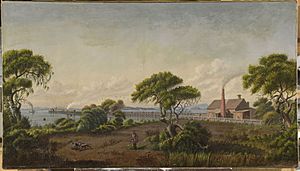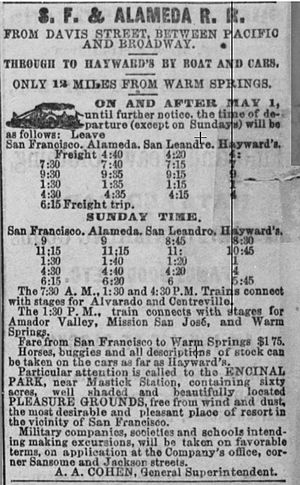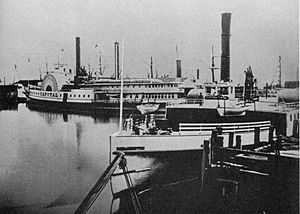San Francisco and Alameda Railroad facts for kids
| Overview | |
|---|---|
| Locale | Northern California |
| Dates of operation | 1864–1870 |
| Successor | Central Pacific Railroad |
| Technical | |
| Track gauge | 4 ft 8 1⁄2 in (1,435 mm) standard gauge |
The San Francisco and Alameda Railroad (SF&A) was a train company that operated for a short time in the East Bay area of the Bay Area. It opened between 1864 and 1865. The train line ran from Alameda Terminal on Alameda Island to Hayward, California. It also offered ferry service from Alameda Terminal to San Francisco starting in 1864.
The company faced problems after the 1868 Hayward earthquake. A larger company, the Central Pacific Railroad, bought it in August 1869. Part of the SF&A line, between Alameda Terminal and San Leandro, became a section of the First Transcontinental Railroad in September 1869. However, most of it was soon replaced by the San Francisco and Oakland Railroad by November 1869. The southern part of the line was no longer used in 1873.
The remaining parts of the line became part of the Southern Pacific Railroad. From 1911 to 1941, the section on Alameda was used for electric commuter trains. Freight trains continued to use the Alameda section until 1960. Today, the middle part of the SF&A line, between Fruitvale and San Leandro, is still in use. It is part of the Union Pacific Railroad and is used by Amtrak passenger trains like the Capitol Corridor and Coast Starlight, as well as Union Pacific freight trains.
Contents
How the Railroad Started
In 1863, a lawyer named A. A. Cohen teamed up with Charles Minturn, who ran river and bay ferries. They also worked with E. B. Mastick, a landowner in Alameda. Together, they started the San Francisco and Alameda Railroad. Their goal was to offer train and ferry services for people and goods. The trains would go to Alameda, San Leandro, and Hayward.
Building the Tracks
Construction began in 1864. Workers built a pier and a train station called Alameda Terminal in Alameda. The tracks started there and followed Pacific Avenue to 4th Street. Then they went along Linnet Street (later Lincoln Avenue) to the Alameda station at Park Street. There were a few stops in between, like Mastick and Encinal. Train service started later that year.
The tracks continued through private land between the Oakland Estuary and San Leandro Bay. At that time, Alameda was a peninsula, not an island. The line went to stations like Fruit Vale (now Fernside) and Simpson's (now Melrose). It then turned southeast to Fitch's (now Fitchburg) and Jones (now Elmhurst). Finally, it reached the Bay side of San Leandro near Davis Street.
In San Leandro, the track turned sharply left onto Ward Street (now West Estudillo Street). It led to the SF&A San Leandro station. The track then turned right to follow the main county road (now East 14th Street in San Leandro and Mission Boulevard in Hayward). Near Hayward, the track angled to A Street and Watkins Street. A station was built at Watkins Street and D Street.
Train service to Hayward began in 1865. There were five trips every day, connecting Hayward to San Francisco. This made it possible for people in Hayward to travel to the city for the first time. However, Hayward only had about 30 homes back then, so the train service was not very profitable.
Joining Bigger Railroads
In 1865, A. A. Cohen also took control of the San Francisco and Oakland Railroad. This company had spent too much money. In April 1868, the Central Pacific Railroad decided that Oakland would be the western end of the First Transcontinental Railroad. A Central Pacific company then bought most of the stock in the San Francisco and Oakland Railroad from Cohen in August 1868.
After the October 1868 Hayward earthquake caused the SF&A to lose money, the Central Pacific company also bought most of its stock. Cohen stayed on as a lawyer for Central Pacific.
By 1866, the Western Pacific Railroad had built a line from San Jose to Vallejo Mills (now part of Fremont). They had planned the rest of the line through Niles Canyon, Livermore Valley, and over Altamont Pass to Stockton and Sacramento. But they ran out of money. A Central Pacific company then took control of the Western Pacific. They finished building the line and added a new line from Niles towards Oakland.
It was decided that the SF&A track north of Hayward, with its sharp turns in San Leandro, was not good for main-line trains. So, the Western Pacific connection was made on the Bay side of San Leandro. This created a new San Leandro station and a direct route to Alameda Pier.
On September 6, 1869, the first transcontinental train arrived in the Bay Area. It ran through Alameda to Alameda Terminal. There, passengers boarded the ferryboat Alameda to go to San Francisco. A special plaque (number 440) marks this important event in California history.
Workers then started building a connection from Simpson's to the San Francisco and Oakland Railroad in San Antonio. When this connection was finished in November, the transcontinental trains started going to Oakland Pier instead. Alameda then went back to having only local train service.
In June 1870, the San Francisco and Oakland Railroad and the SF&A merged. They formed the San Francisco, Oakland and Alameda Railroad. This new company lasted only two months before it became part of the Central Pacific Railroad.
In 1873, the Central Pacific Railroad made some budget cuts. The Alameda train service now used a new track north from Fernside station. This track ran alongside Fruitvale Avenue to a new Fruitvale station. This station was at the point where it joined the main Central Pacific line from Oakland. The trains ended their journey there. The old SF&A line from San Leandro to Hayward was closed, even though the towns protested.
New tracks were laid north from Mastick station to a bridge over the Oakland Estuary. This bridge connected to Alice Street, and the tracks continued along this street to 7th Street. This allowed Alameda trains to go all the way to Oakland Pier. The old Alameda Pier (at Pacific Avenue) was no longer used.
In 1887, the Central Pacific Railroad was leased to the Southern Pacific Railroad. In 1898, the Alice Street bridge and tracks to 7th Street in Oakland were replaced. A new bridge to Harrison Street was built, connecting to the 1st Street line to Oakland Pier. In 1903, the Oakland Tidal Canal was finished. This canal linked the Oakland Estuary with San Leandro Bay, making Alameda into an island. This also required building the Fruitvale Bridge. In 1906, some Alameda trains started using the newer Alameda Pier. This pier was originally built by the South Pacific Coast Railroad.
Later Years of the Railroad
In 1911, the Southern Pacific Railroad added electricity to most of its local train lines in the East Bay. The electric Alameda line, called the Lincoln Avenue line, went from Alameda Pier. It followed the original Pacific Avenue tracks to Alameda and Fernside stations. Then it went around the eastern end of Alameda to connect with the Encinal Avenue line.
In 1939, Alameda Pier was closed. The Lincoln Avenue line then continued past Alameda station and across the Fruitvale Bridge. It connected with the 7th Street line at the later Fruitvale station. The trains then followed the 7th Street line through Oakland and across the San Francisco-Oakland Bay Bridge to the San Francisco Transbay Terminal. This was a longer way for passengers from western Alameda to get to San Francisco.
Passenger service stopped in January 1941. It was replaced by Key System buses that used a shorter route through a tunnel (Posey Tube). However, freight trains continued to use most of the route. The very last passenger train on this line was a special trip for a railroad club in April 1954. Freight service ended in 1960, and the tracks were removed.
Ferryboats Used
The first ferryboat used by the SF&A was called Sophie MacLane. It was a river boat rented from Charles Minturn's company. But it was too small. So, it went back to serving the Sacramento River. Minturn then moved the Contra Costa to the SF&A route. This ferryboat was built to go from San Francisco to Broadway in Oakland.
As more people used the service, even the Contra Costa became too small. So, the SF&A had a new ferryboat built. It was finished in January 1866 and was named Alameda. It was the first ferryboat on the Bay that could go in both directions without turning around. After the Central Pacific Railroad took over the SF&A, the Alameda joined the Central Pacific's group of ferryboats. It served in different places around the Bay.
Train Engines
The first order for train engines was for two small ones, called 2-2-0 type. They arrived in 1864. One was named E. B. Mastick, and the other was sold to a railroad in Southern California. Soon after service started, the company realized they needed a stronger engine. So, the SF&A built the J. C. Kellogg, which was a 4-4-0 type. In 1868, another 4-4-0 engine was ordered and delivered. It was named the F. D. Atherton. This engine was badly damaged in a crash the next year but was rebuilt. When the Central Pacific Railroad took over the SF&A, they brought in other engines. The three SF&A engines were then sent to other parts of the Central Pacific system.
| Name | Builder | Type | Date | Notes |
|---|---|---|---|---|
| Vulcan Iron Works, San Francisco | 2-2-0 | 1864 | Sold to Los Angeles & San Pedro RR as San Gabriel; destroyed by boiler explosion in 1869. | |
| E.B.Mastick | Vulcan Iron Works, San Francisco | 2-2-0 | 1864 | Became Central Pacific RR Oakland shop switcher in 1870; scrapped in 1874. |
| J.G.Kellogg | SF&A shops | 4-4-0 | Became California Pacific RR # 176; then Stockton & Copperopolis # 2; then Southern Pacific # 1100; retired 1891. | |
| F.D.Atherton | Grant Locomotive Works | 4-4-0 | 1868 | Crashed in 1869; rebuilt as Central Pacific RR #177 in 1873. |
Train Accident
On November 14, 1869, the first big train accident in California happened east of Simpson's. The morning transcontinental train, heading east, left Oakland Pier but was running late. The morning SF&A local train, coming from Hayward, was also delayed. They were supposed to pass each other at Simpson's. That morning, Simpson's was covered in heavy fog.
The transcontinental train arrived at Simpson's first. There was some confusion with the switchman (the person who changes the tracks). Thinking the local train had already passed, the transcontinental train went east quickly into the fog. It crashed into the local train.
Fifteen people were killed, including four from the train crews. Twenty-one passengers were hurt, some very seriously. Both train engines were badly damaged but were rebuilt. Several passenger cars were destroyed. An investigation found that the switchman was careless. He was tried for manslaughter but was found not guilty. Soon after, a second track was built between Simpson's and San Leandro to prevent future accidents.




